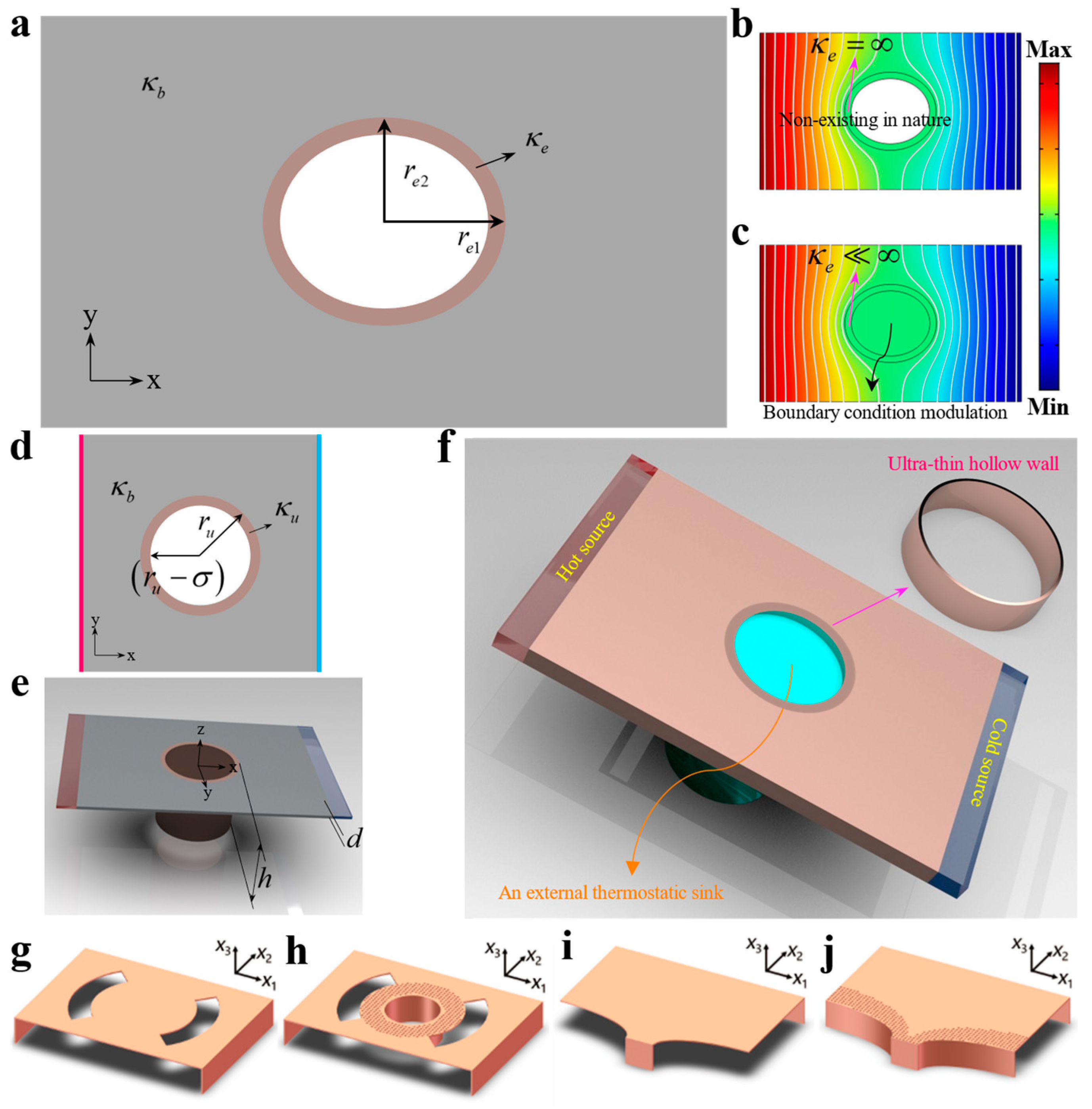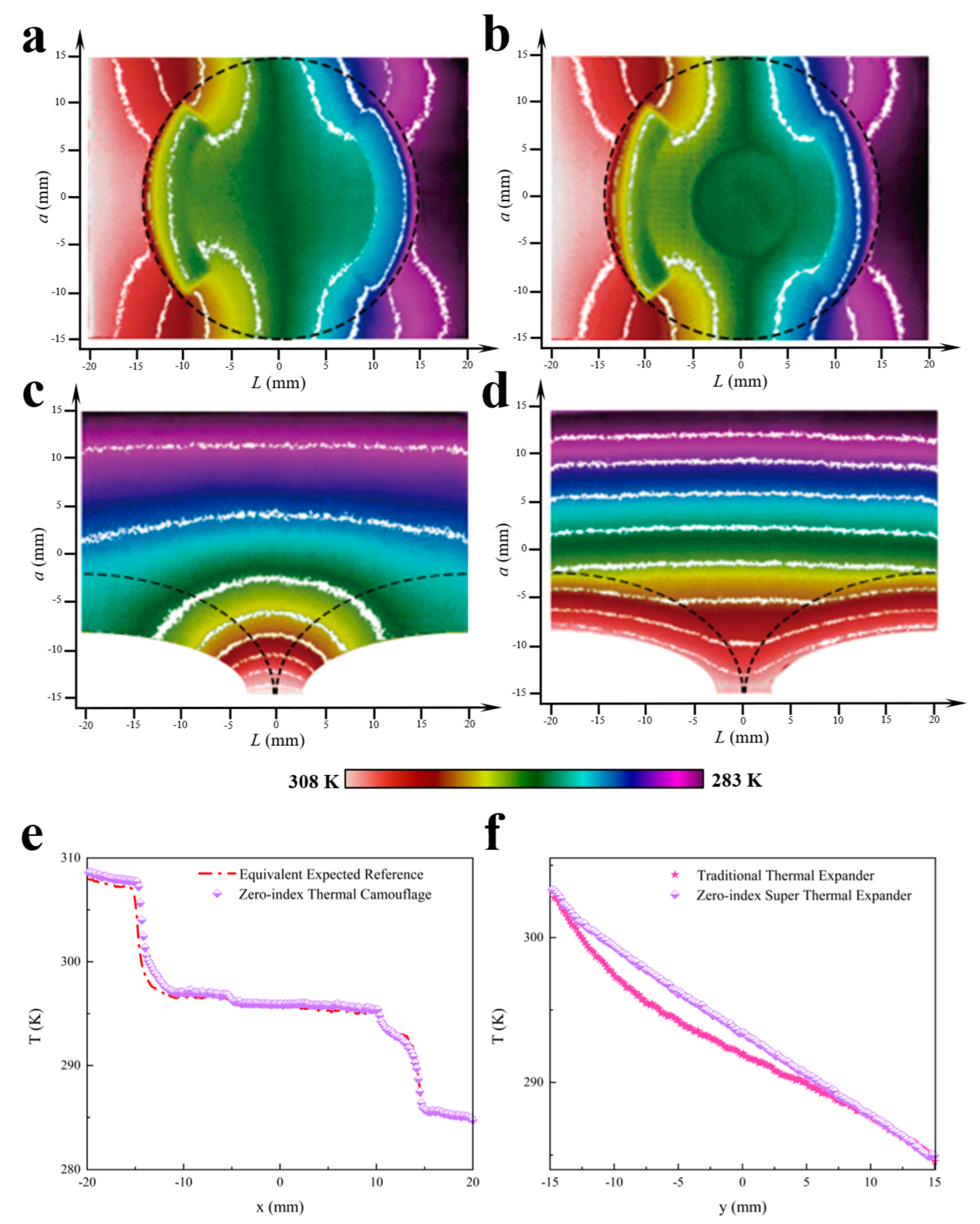Homogeneous Zero-Index Thermal Metadevice for Thermal Camouflaging and Super-Expanding
Abstract
:1. Introduction
2. Theoretical Analysis
3. Results and Discussions
4. Conclusions
Supplementary Materials
Author Contributions
Funding
Institutional Review Board Statement
Informed Consent Statement
Data Availability Statement
Acknowledgments
Conflicts of Interest
References
- Pendry, J.B.; Schurig, D.; Smith, D.R. Controlling electromagnetic fields. Science 2006, 312, 1780–1782. [Google Scholar] [CrossRef] [PubMed]
- Hu, R.; Xi, W.; Liu, Y.; Tang, K.; Song, J.; Luo, X.; Wu, J.; Qiu, C.-W. Thermal camouflaging metamaterials. Mater. Today 2021, 45, 120–141. [Google Scholar] [CrossRef]
- Jin, Z.; Janoschka, D.; Deng, J.; Ge, L.; Dreher, P.; Frank, B.; Hu, G.; Ni, J.; Yang, Y.; Li, J.; et al. Phyllotaxis-inspired nanosieves with multiplexed orbital angular momentum. eLight 2021, 1, 5. [Google Scholar] [CrossRef]
- Yan, W.; Dong, C.; Xiang, Y.; Jiang, S.; Leber, A.; Loke, G.; Xu, W.; Hou, C.; Zhou, S.; Chen, M.; et al. Thermally drawn advanced functional fibers: New frontier of flexible electronics. Mater. Today 2020, 35, 168–194. [Google Scholar] [CrossRef]
- Alù, A.; Engheta, N. Achieving transparency with plasmonic and metamaterial coatings. Phys. Rev. E 2005, 72, 016623. [Google Scholar] [CrossRef] [PubMed]
- Alù, A.; Engheta, N. Multifrequency optical invisibility cloak with layered plasmonic shells. Phys. Rev. Lett. 2008, 100, 113901. [Google Scholar] [CrossRef]
- Li, Y.; Shen, X.; Wu, Z.; Huang, J.; Chen, Y.; Ni, Y.; Huang, J. Temperature-dependent transformation thermotics: From switchable thermal cloaks to macroscopic thermal diodes. Phys. Rev. Lett. 2015, 115, 195503. [Google Scholar] [CrossRef]
- Xiao, Y.; Chen, Q.; Hao, Q. Inverse thermal design of nanoporous thin films for thermal cloaking. Mater. Today Phys. 2021, 21, 100477. [Google Scholar] [CrossRef]
- Li, J.; Li, Y.; Li, T.; Wang, W.; Li, L.; Qiu, C.-W. Doublet thermal metadevice. Phys. Rev. Appl. 2019, 11, 044021. [Google Scholar] [CrossRef]
- Xu, G.; Dong, K.; Li, Y.; Li, H.; Liu, K.; Li, L.; Wu, J.; Qiu, C.-W. Tunable analog thermal material. Nat. Commun. 2020, 11, 6028. [Google Scholar] [CrossRef]
- Li, J.; Li, Y.; Cao, P.; Yang, T.; Zhu, X.; Wang, W.; Qiu, C. A continuously tunable solid-like convective thermal metadevice on the reciprocal line. Adv. Mater. 2020, 32, 2003823. [Google Scholar] [CrossRef] [PubMed]
- Zhu, Z.; Ren, X.; Sha, W.; Xiao, M.; Hu, R.; Luo, X. Inverse design of rotating metadevice for adaptive thermal cloaking. Int. J. Heat Mass Transf. 2021, 176, 121417. [Google Scholar] [CrossRef]
- Sha, W.; Xiao, M.; Zhang, J.; Ren, X.; Zhu, Z.; Zhang, Y.; Xu, G.; Li, H.; Liu, X.; Chen, X.; et al. Robustly printable freeform thermal metamaterials. Nat. Commun. 2021, 12, 7228. [Google Scholar] [CrossRef] [PubMed]
- Li, Y.; Li, W.; Han, T.; Zheng, X.; Li, J.; Li, B.; Fan, S.; Qiu, C.-W. Transforming heat transfer with thermal metamaterials and devices. Nat. Rev. Mater. 2021, 6, 488–507. [Google Scholar] [CrossRef]
- Li, Y.; Zhu, K.-J.; Peng, Y.-G.; Li, W.; Yang, T.; Xu, H.-X.; Chen, H.; Zhu, X.-F.; Fan, S.; Qiu, C.-W. Thermal meta-device in analogue of zero-index photonics. Nat. Mater. 2019, 18, 48–54. [Google Scholar] [CrossRef]
- Balandin, A.A.; Ghosh, S.; Bao, W.; Calizo, I.; Teweldebrhan, D.; Miao, F.; Lau, C.N. Superior thermal conductivity of single-layer graphene. Nano Lett. 2008, 8, 902–907. [Google Scholar] [CrossRef]
- Huang, J.; Shen, X.; Jiang, C.; Wu, Z.; Huang, J. Thermal expander. Phys. B Condens. Matter 2017, 518, 56–60. [Google Scholar] [CrossRef]
- Xu, L.; Huang, J. Metamaterials for Manipulating Thermal Radiation: Transparency, Cloak, and Expander. Phys. Rev. Appl. 2019, 12, 044048. [Google Scholar] [CrossRef]
- Hu, R.; Zhou, S.; Li, Y.; Lei, D.; Luo, X.; Qiu, C.-W. Illusion thermotics. Adv. Mater. 2018, 30, e1707237. [Google Scholar] [CrossRef]
- Li, Y.; Bai, X.; Yang, T.; Luo, H.; Qiu, C.-W. Structured thermal surface for radiative camouflage. Nat. Commun. 2018, 9, 273. [Google Scholar] [CrossRef]
- Hu, R.; Huang, S.; Wang, M.; Luo, X.; Shiomi, J.; Qiu, C.-W. Encrypted thermal printing with regionalization transformation. Adv. Mater. 2019, 31, e1807849. [Google Scholar] [CrossRef] [PubMed]
- Liu, Y.; Song, J.; Zhao, W.; Ren, X.; Cheng, Q.; Luo, X.; Fang, N.X.; Hu, R. Dynamic thermal camouflage via a liquid-crystal-based radiative metasurface. Nanophotonics 2020, 9, 855–863. [Google Scholar] [CrossRef]
- Han, T.; Bai, X.; Thong, J.T.L.; Li, B.; Qiu, C.-W. Full control and manipulation of heat signatures: Cloaking, camouflage and thermal metamaterials. Adv. Mater. 2014, 26, 1731–1734. [Google Scholar] [CrossRef] [PubMed]
- Huang, X.; Lai, Y.; Hang, Z.H.; Zheng, H.; Chan, C.T. Dirac cones induced by accidental degeneracy in photonic crystals and zero-refractive-index materials. Nat. Mater. 2011, 10, 582–586. [Google Scholar] [CrossRef] [PubMed]
- Maas, R.; Parsons, J.; Engheta, N.; Polman, A. Experimental realization of an epsilon-near-zero metamaterial at visible wavelengths. Nat. Photon. 2013, 7, 907–912. [Google Scholar] [CrossRef]
- Wu, Y.; Li, J. Total reflection and cloaking by zero index metamaterials loaded with rectangular dielectric defects. Appl. Phys. Lett. 2013, 102, 183105. [Google Scholar] [CrossRef]
- Li, Y.; Kita, S.; Muñoz, P.; Reshef, O.; Vulis, D.I.; Yin, M.; Lončar, M.; Mazur, E. On-chip zero-index metamaterials. Nat. Photon. 2015, 9, 738–742. [Google Scholar] [CrossRef]
- Alam, M.Z.; De Leon, I.; Boyd, R.W. Large optical nonlinearity of indium tin oxide in its epsilon-near-zero region. Science 2016, 352, 795–797. [Google Scholar] [CrossRef]
- Alam, M.Z.; Schulz, S.A.; Upham, J.; De Leon, I.; Boyd, R.W. Large optical nonlinearity of nanoantennas coupled to an epsilon-near-zero material. Nat. Photon. 2018, 12, 79–83. [Google Scholar] [CrossRef]
- Xu, L.J.; Yang, S.; Huang, J.P. Effectively infinite thermal conductivity and zero-index thermal cloak. EPL 2020, 131, 24002. [Google Scholar] [CrossRef]
- Chu, H.; Li, Q.; Liu, B.; Luo, J.; Sun, S.; Hang, Z.H.; Zhou, L.; Lai, Y. A hybrid invisibility cloak based on integration of transparent metasurfaces and zero-index materials. Light. Sci. Appl. 2018, 7, 50. [Google Scholar] [CrossRef] [PubMed]
- Yang, S.; Wang, J.; Dai, G.; Yang, F.; Huang, J. Controlling macroscopic heat transfer with thermal metamaterials: Theory, experiment and application. Phys. Rep. 2021, 908, 1–65. [Google Scholar] [CrossRef]
- Han, T.; Bai, X.; Gao, D.; Thong, J.; Li, B.; Qiu, C.-W. Experimental demonstration of a bilayer thermal cloak. Phys. Rev. Lett. 2014, 112, 054302. [Google Scholar] [CrossRef]
- Han, T.; Yang, P.; Li, Y.; Lei, D.; Li, B.; Hippalgaonkar, K.; Qiu, C.-W. Full-parameter omnidirectional thermal metadevices of anisotropic geometry. Adv. Mater. 2018, 30, e1804019. [Google Scholar] [CrossRef] [PubMed]
- Yang, S.; Xu, L.J.; Wang, R.Z.; Huang, J.P. Full control of heat transfer in single-particle structural materials. Appl. Phys. Lett. 2017, 111, 121908. [Google Scholar] [CrossRef]
- Li, Y.; Qi, M.; Li, J.; Cao, P.-C.; Wang, D.; Zhu, X.-F.; Qiu, C.-W.; Chen, H. Heat transfer control using a thermal analogue of coherent perfect absorption. Nat. Commun. 2022, 13, 2683. [Google Scholar] [CrossRef] [PubMed]
- Guo, J.; Xu, G.; Tian, D.; Qu, Z.; Qiu, C.-W. Passive Ultra-Conductive Thermal Metamaterials. Adv. Mater. 2022, 34, 2200329. [Google Scholar] [CrossRef]




Disclaimer/Publisher’s Note: The statements, opinions and data contained in all publications are solely those of the individual author(s) and contributor(s) and not of MDPI and/or the editor(s). MDPI and/or the editor(s) disclaim responsibility for any injury to people or property resulting from any ideas, methods, instructions or products referred to in the content. |
© 2023 by the authors. Licensee MDPI, Basel, Switzerland. This article is an open access article distributed under the terms and conditions of the Creative Commons Attribution (CC BY) license (https://creativecommons.org/licenses/by/4.0/).
Share and Cite
Li, H.; Liu, K.; Liu, T.; Hu, R. Homogeneous Zero-Index Thermal Metadevice for Thermal Camouflaging and Super-Expanding. Materials 2023, 16, 3657. https://doi.org/10.3390/ma16103657
Li H, Liu K, Liu T, Hu R. Homogeneous Zero-Index Thermal Metadevice for Thermal Camouflaging and Super-Expanding. Materials. 2023; 16(10):3657. https://doi.org/10.3390/ma16103657
Chicago/Turabian StyleLi, Huagen, Kaipeng Liu, Tianfeng Liu, and Run Hu. 2023. "Homogeneous Zero-Index Thermal Metadevice for Thermal Camouflaging and Super-Expanding" Materials 16, no. 10: 3657. https://doi.org/10.3390/ma16103657



